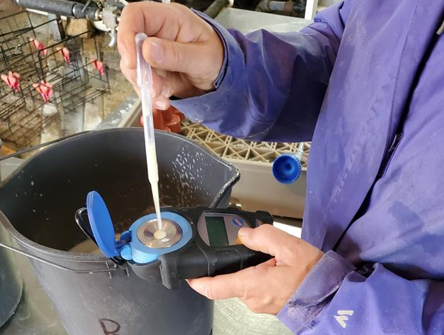Could pooling high-quality colostrum benefit long-term calf immunity?
by Cari Reynolds, W.H. Miner Institute
To ensure that calves achieve adequate passive transfer, feeding colostrum from a single dam is considered the standard. Pooling of colostrum is generally discouraged due to high risk of disease transmission and lowered colostrum quality due to the variability of immunoglobulin (IgG) levels among dams. In the spirit of efficiency, pooling colostrum on farms is not uncommon. A 2018 review of U.S. pre-weaned heifer raising practices published in the Journal of Dairy Science reported that of 104 farms surveyed across 13 states, 33 of those farms still pooled colostrum. Calves on U.S. farms fed pooled colostrum were 2.2 times more likely to experience failure of passive transfer than those calves fed colostrum from a single dam.
If colostrum is pooled, it is recommended that only high-quality colostrum (≥50 mg/mL IgG or ≥22% Brix) from healthy cows is used, and pooling should not be practiced in situations where diseases could be transmitted through colostrum (i.e. Johne’s Disease). But since every cow is different in terms of pathogen exposure and immune function, could pooling of colostrum (if of high quality) actually be of benefit to the calf in terms of exposure to disease-specific antibodies and other immune qualities from different dams?
A recent article appearing in the Journal of Dairy Science from Teagasc, the agriculture and food development authority of Ireland, sought to close this knowledge gap by evaluating if pooled colostrum from several cows actually broadened the variety of antibodies that a calf received, and if this practice would improve disease-specific immunity throughout the first year of life. There is currently little data to compare immunity in calves fed either single-dam or pooled colostrum, and also to determine even in herds where mean colostrum IgG is high, if pooling can still affect colostrum quality. Understanding if there are differences in immunity between colostrum sources would give new insight and understanding of the places that pooled colostrum could be used.
In a nonconsecutive two-year study (2016 and 2018) that included 320 cows and 120 heifer calves (either Holstein-Friesian or Holstein-Friesian x Jersey), blood samples were taken from the cows close to parturition to determine immune profile and exposure to common infectious pathogens. Enrolled calves received one of three treatments: maternal colostrum (MC), nonmaternal colostrum (NMC; colostrum from another dam), or pooled colostrum (PC) from several cows at equal ratios. Colostrum was tested with a Brix refractometer to ensure that quality across all three treatment groups remained similar, and any colostrum with a Brix reading below 22% was not used. Calves in each treatment group received colostrum within 2 hours of birth at 8.5% of body weight, and either received subsequent feedings of milk replacer (calves enrolled in 2016) or transition milk from the same source as their treatment assignment (calves enrolled in 2018).

Despite variability in mean colostrum IgG between 2016 and 2018 (71.2 and 97.0 mg/mL, respectively), colostrum quality across both study years remained extremely high (mean 84.2 mg/mL). There were no differences in IgG concentrations between the pooled colostrum and the sources used for pooling, and colostrum IgG concentrations were highest in the NMC treatment group (mean 94.2 mg/mL). However, 24-hour serum IgG concentrations were greater in those calves fed colostrum from a single dam (either maternal or nonmaternal). Apparent efficiency of absorption (AEA), or the amount of IgG absorbed into the calf’s system relative to the amount of IgG that was ingested, was lower in those calves receiving pooled colostrum. This may be attributable to IgG in the gut binding to the variety of pathogens present in pooled colostrum, leaving less to be absorbed into the bloodstream. At 1 month of age, calves in the MC treatment group had the highest number of antibodies to bovine viral diarrhea (BVD), but no treatment effect was observed for other common diseases. Regardless of treatment, maternal antibody survival rates in the calves ranged from 4-7 months for a range of diseases, including BVD, Salmonella, Leptospirosis, parainfluenza virus (PI-3), bovine respiratory syncytial virus (BRSV), Rotavirus, and Coronavirus. These results suggest that high-quality colostrum, whether pooled or single-dam, provided calves with cross-protection against different strains of bacteria and viruses and explains the similar immunity across groups. However, more work to determine the exact relationship between colostrum and disease-specific immunity is necessary. It is also important to note that the colostrum in this study was not subjected to heat treatment, which may have resulted in more immunoglobulins available for absorption. Higher colostrum IgG concentration, as well as feeding of transition milk to those calves enrolled in 2018, may also have influenced antibody survival rates.
This study suggests that if best practices are followed when pooling colostrum (only using good quality from healthy cows, equal portions across cows, and proper storage), adequate levels of IgG could be maintained. Rigorous criteria and management is very important to be able to successfully use pooled colostrum, and feeding individual sources is still highly encouraged as much more information is still needed to fully understand if there could be additional benefit. So whether you keep it single or choose to mingle, ensuring colostrum quality is still the best way to set calves up for success.
Cari Reynolds earned a BS in Biology from University of Scranton and a Master of Public Health from the University of Massachusetts – Amherst. After several years working in the public health sector, Cari returned to her agricultural interests and she is currently a research intern at W.H. Miner Institute. Cari is a Ph.D. student in Animal Science at University of Vermont, where her research will focus on management and preventative strategies to mitigate diseases that impact both human and animal health. She can be reached at reynolds@whminer.com.
